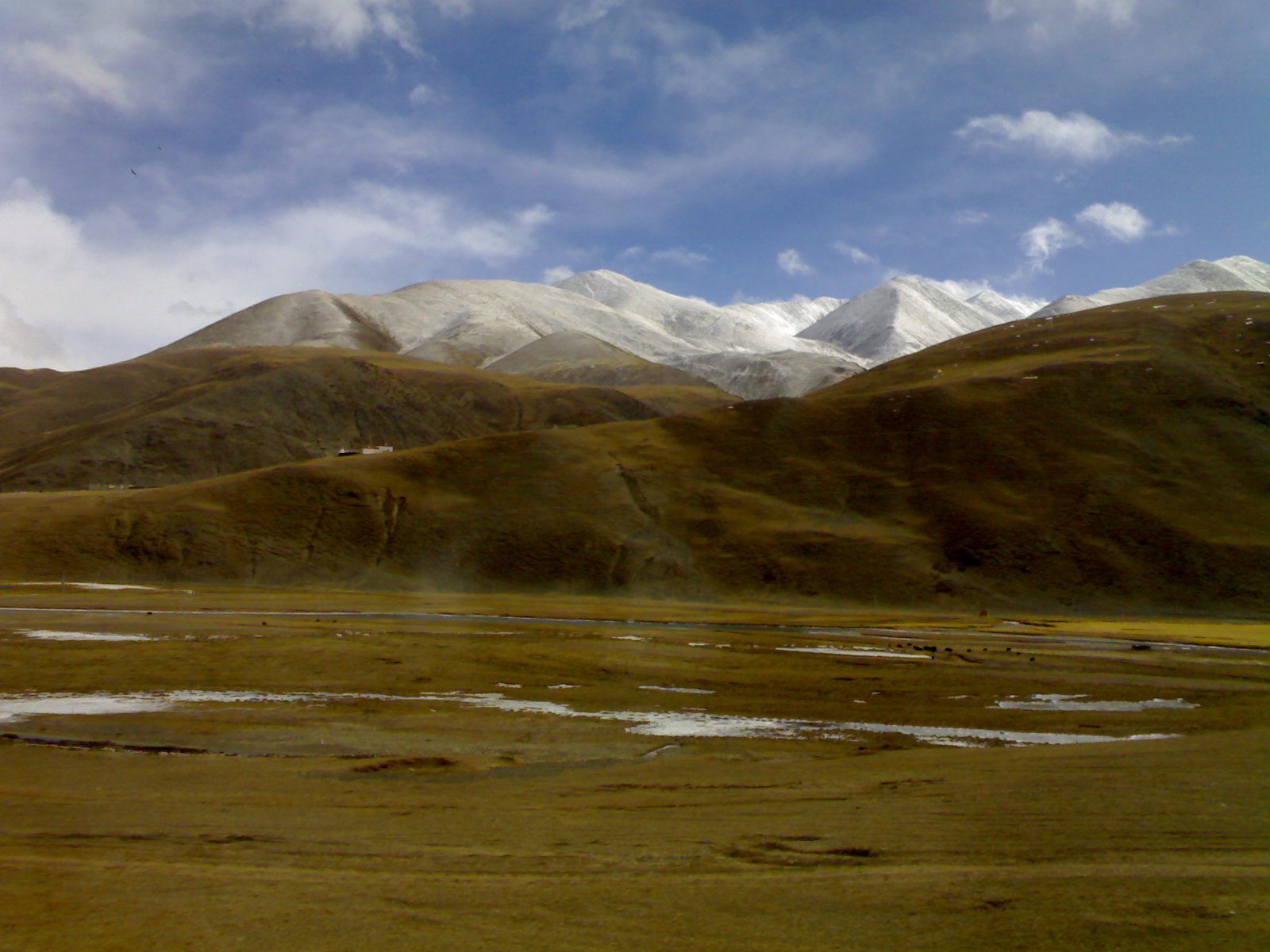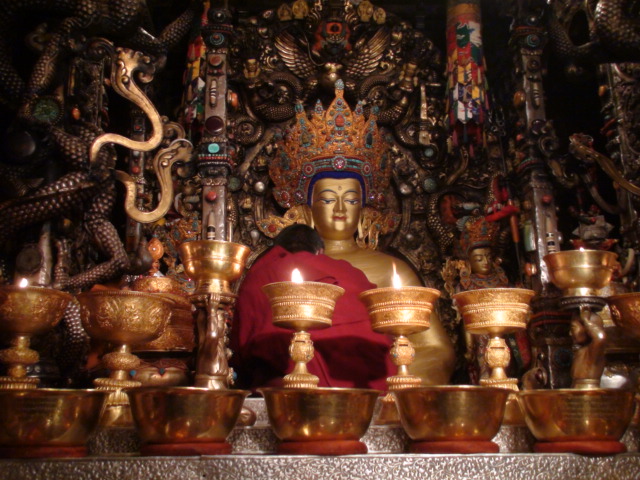 In China it seems that most things are described as “The [X] of [Y]”, so you don’t really have to be a genius to understand how Tibet came to be called “The rooftop of the world.” We’re 3700 meters above sea level, and the train that got me here went along the highest altitude railroad in the world, at 5072 meters at the highest point. It didn’t really seem that high, though, as we were rolling along on a vast plateau, with much higher mountains on both sides.
In China it seems that most things are described as “The [X] of [Y]”, so you don’t really have to be a genius to understand how Tibet came to be called “The rooftop of the world.” We’re 3700 meters above sea level, and the train that got me here went along the highest altitude railroad in the world, at 5072 meters at the highest point. It didn’t really seem that high, though, as we were rolling along on a vast plateau, with much higher mountains on both sides.
I spent New Year’s Eve on the train, and it was rather uneventful. It was just another Wednesday night in China, seeing as new year here isn’t until January 26. The lights in my carriage went out at 9:30, and the restaurant car closed at 10… Anyway, I wish all of you a wonderful 2009!
When I arrived in Lhasa, I was picked up by my tour operator Lee Jack and my driver(!), and presented with a traditional white scarf for good luck. When we arrived at the hostel, I was warned that in order to avoid altitude sickness, I shouldn’t shower in the first 24 hours, nor smoke, drink alcohol, eat meat, fat or spicy food, get winded for any reason, and in general just relax as much as possible. High altitude sickness, or Acute Mountain Sickness as they call it, presents with headaches, fatigue, sleeplessness, nausea, or if you will: The Worst Hangover Ever. If symptoms are ignored it may be fatal, so I decided to be safe rather than sorry…
The first night here, I just wandered (slowly) into the quaint Tibetan back alleys, found a food market, and the muslim quarter. I ate a vegetarian supper in a hole-in-the-wall restaurant, where the cook/serving woman looked terror stricken at the prospect of having to communicate with a Foreigner… 🙂 The food was amazing, though, when I finally managed to communicate that I couldn’t eat meat, fat and spice, as it was my first night on the plateau. The dormitory where I stay in the hostel has 12 beds (6 bunk beds) but is only occupied by me, a Chinese guy, and four Chinese girls. It set me back the staggering sum of 15 NOK per night…
I had the best night’s sleep in over a week (the Chinese medicine did the trick for my stomach!) and the next morning I went out to a place called Jokhang, where I had breakfast in a traditional Tibetan restaurant. I had yak dumplings, fried barley flour (Tsampa) and salty tea with yak butter… The place was pretty full, so I shared a table with a family of Tibetan pilgrims who, as a matter of course, shared what they ordered with me, and I shared my food with them!
I got into the Jokhang Temple in the busiest period of the day, when lots and lots of pilgrims were paying their dues to the buddhas in the temple, so I was basically standing in a long line, going through all the little chapels in the temple.
 Actually, the way I found the temple in the first place, was when I came out from a small side street, onto a wider pedestrian where everybody were moving the same direction… Most were dressed in traditional style, with amazing hairdoes, involving braided hair, sometimes intertwined with colourful threads. That went for both men and women, although some of the men were wearing ornate swords at their sides! Quite a few were prostrating themselves, laying all the way down on their stomach, forehead to the ground, every three steps! When I reached the front of the temple, there was a roped-off area, where dozens of people were laying down, getting up and laying back down over and over again!
Actually, the way I found the temple in the first place, was when I came out from a small side street, onto a wider pedestrian where everybody were moving the same direction… Most were dressed in traditional style, with amazing hairdoes, involving braided hair, sometimes intertwined with colourful threads. That went for both men and women, although some of the men were wearing ornate swords at their sides! Quite a few were prostrating themselves, laying all the way down on their stomach, forehead to the ground, every three steps! When I reached the front of the temple, there was a roped-off area, where dozens of people were laying down, getting up and laying back down over and over again!
 When I’d done the whole circuit of the temple with the crowd of pilgrims, I went up to the roof, which was pretty awesome! The temple was built 1300 years ago, and although it has been partly destroyed and rebuilt several times over the past millennium, it still had that ancient feel of strong spirituality. From the roof it was clearly visible that the whole thing was built much like a maze, I assume in order to let light down into the lower interior rooms of the structure. I wandered aimlessly around on the roof, and stumbled upon a guy making (or maybe repairing) buddha statues, and in another place a couple of carpenters apparently preparing beams and posts that would replace crumbling ones around the massive structure. I also wound up on a stretch of roof that had a distinct off-limits feel to it, seeing as I was the only one there, and there were the occasional monk washing his cape, making tea and generally going about their business.
When I’d done the whole circuit of the temple with the crowd of pilgrims, I went up to the roof, which was pretty awesome! The temple was built 1300 years ago, and although it has been partly destroyed and rebuilt several times over the past millennium, it still had that ancient feel of strong spirituality. From the roof it was clearly visible that the whole thing was built much like a maze, I assume in order to let light down into the lower interior rooms of the structure. I wandered aimlessly around on the roof, and stumbled upon a guy making (or maybe repairing) buddha statues, and in another place a couple of carpenters apparently preparing beams and posts that would replace crumbling ones around the massive structure. I also wound up on a stretch of roof that had a distinct off-limits feel to it, seeing as I was the only one there, and there were the occasional monk washing his cape, making tea and generally going about their business.
In the evening, 24 hours after my own arrival, the couple I’ll be travelling with in Tibet in order to share the cost of the obligatory car, driver and guide, arrived. Gabrielle and Christoffer are in their mid forties, and have been (in their own words) semi-nomadic for the past 16 years. In spring and fall they work as teachers back home in the US, to make money for further travelling! Today we went toghether to Potala palace, which is the most famous structure in Tibet. It is pretty easy to locate, it is the one that “touches the sky!” The massive red and white building is (according to a plaque at the entrance) 115,703 😉 meters high, and was the seat of the 6th to the 13th Dalai Lama, from the 17th century till 1959, when the current (14th) Dalai Lama had to flee from the Chinese liberators/invaders. Most people here put on a wide grin when they find out I’m Norwegian, and say something along the lines of “Oslo! Dalai Lama! Nobel Peace Price!”
It is pretty obvious that Tibet is occupied territory. At every street corner there are four Chinese military guards, two with riot shields, and two with what I suspect are tear gas launchers. They also patrol all large open spaces in fours, sit on rooftops with their launchers, march around in large groups, or hang around the temples in their “civilian” dark blue no-brand track suits. Today I was stopped by one of the latter, had to show him all the pictures on my camera, and delete any pic that had any sign of military presence in it! Because the button that scrolls through pictures on my camera sometimes takes two or event three pictures at a time I managed to keep one; a picture of guards on a rooftop next to the Jokhang Temple… If the government finds this, they’ll probably ban gjerulf.com from all net users in China, and possibly deport me if they find out where I am…
The Chinese name themselves the liberators of the Tibetan people, which to some extent is true, as Tibet was a feudal serfdom before the Chinese arrived, and most people lived basically as slaves, in extremely poor conditions. Whether exchanging one oppressive regime with another one can be considered liberation is a different story. The undebatable truth is that Tibet is a much richer and more developed country today than it was before the Chinese arrived. Another truth is that the Chinese culture is on the verge of overwhelming the local Tibetan culture, which would be a great loss. In the future people might have to go to museums to see the pilgrims, full of grime and with bloody foreheads from hundreds of kilometers of prostrating every three steps, see the colourful clothes and headdresses, the men with the swords and all the things that make Lhasa unforgettable…
I don’t know how internet access will be the coming week, travelling through the inner parts of Tibet, so my next entry might be posted from Kathmandu, Nepal. I’m considering going to the Nepalese embassy tomorrow to get my visa, since it’s supposed to be cheaper here than on the border. I am looking forward to visiting Mount Everest Base Camp, which looks to be accessible even though it’s bloody freezing up there. Can’t get as bad as Mongolia, though. Or can it? Will those be my famous last words? 😛